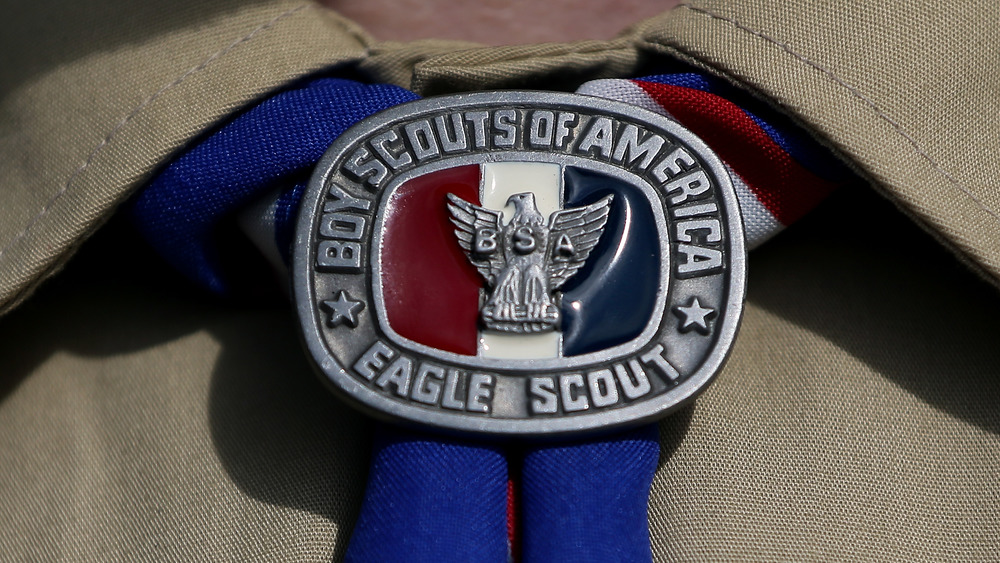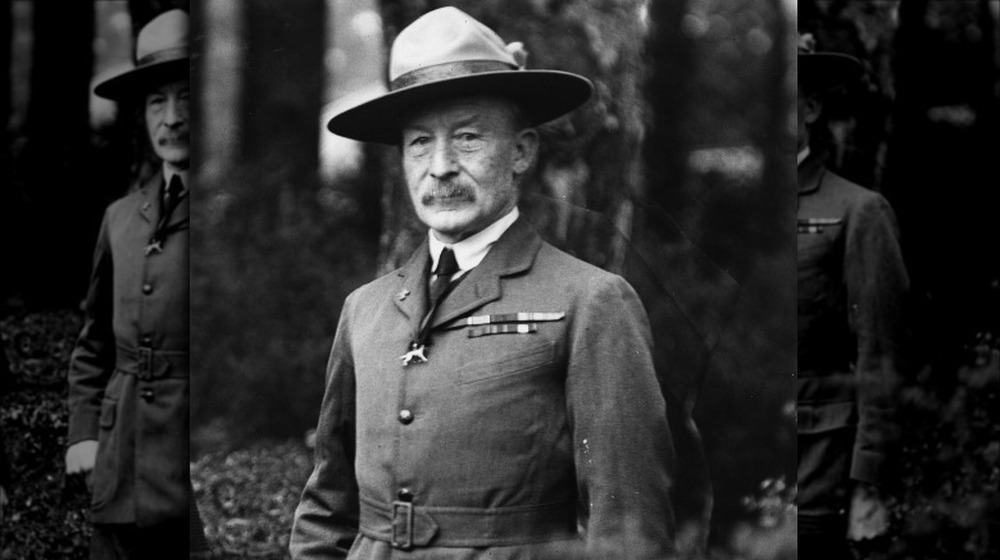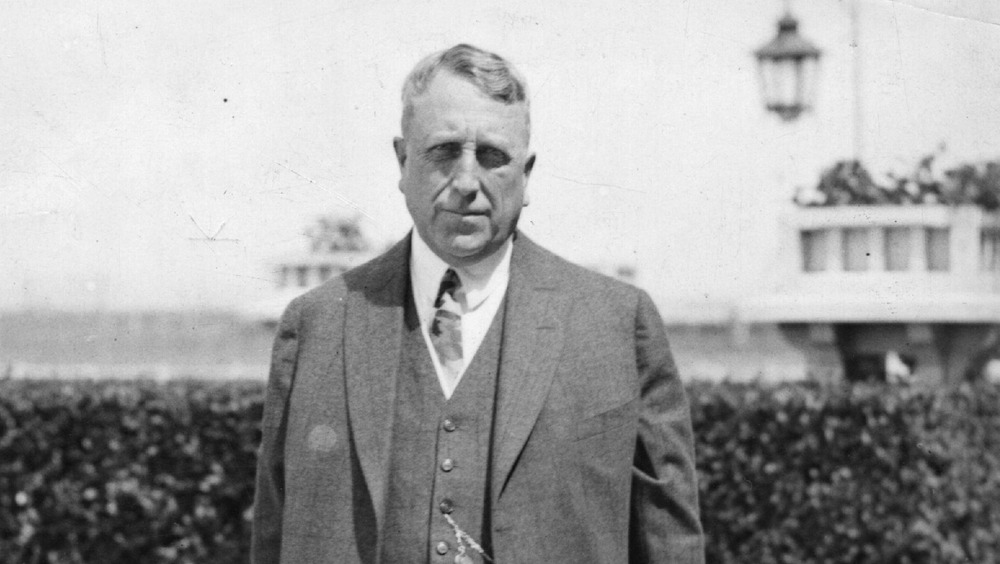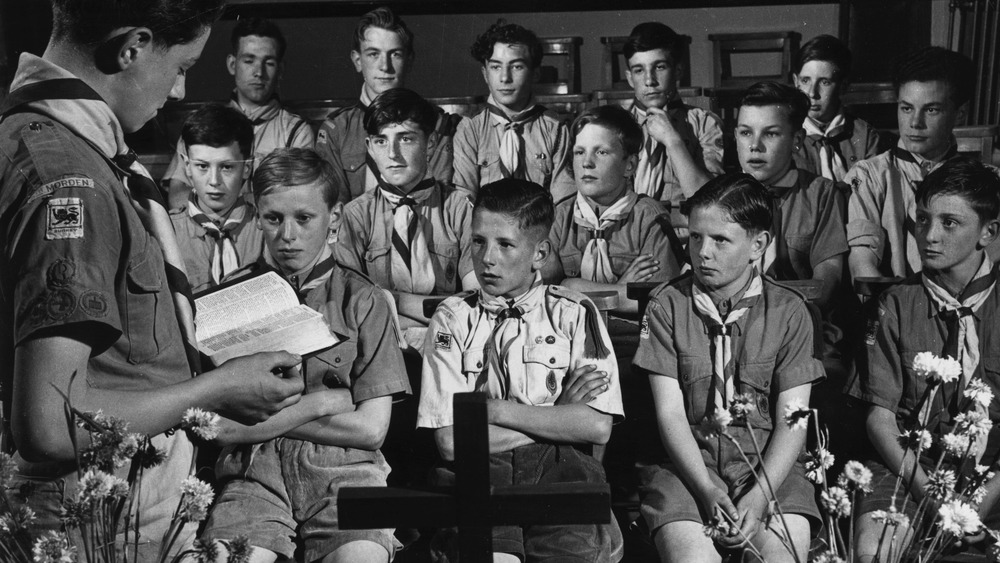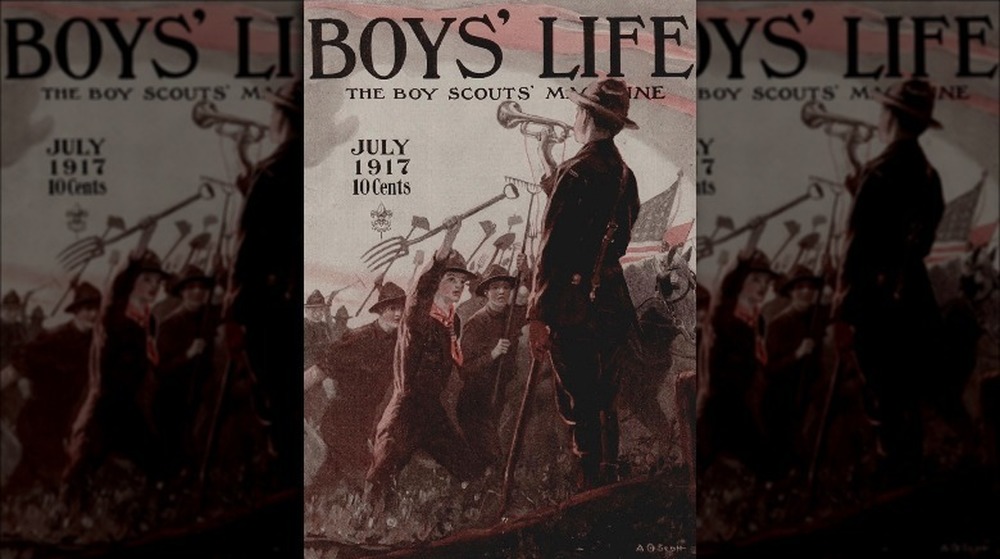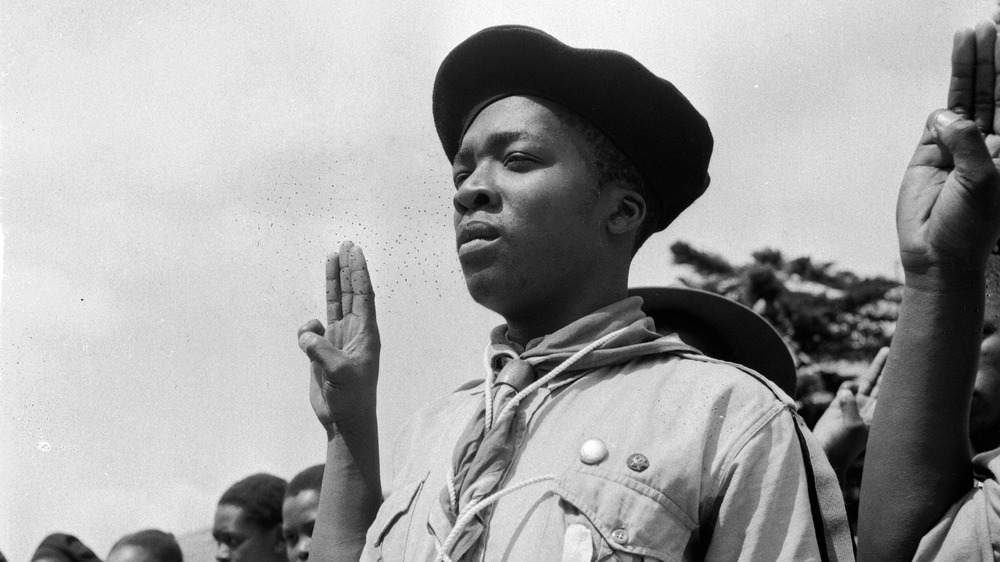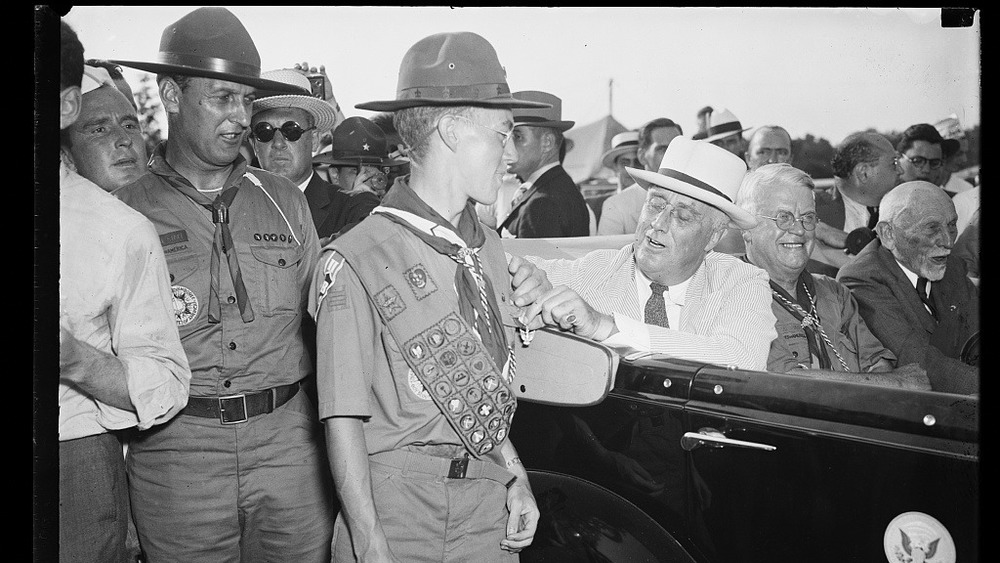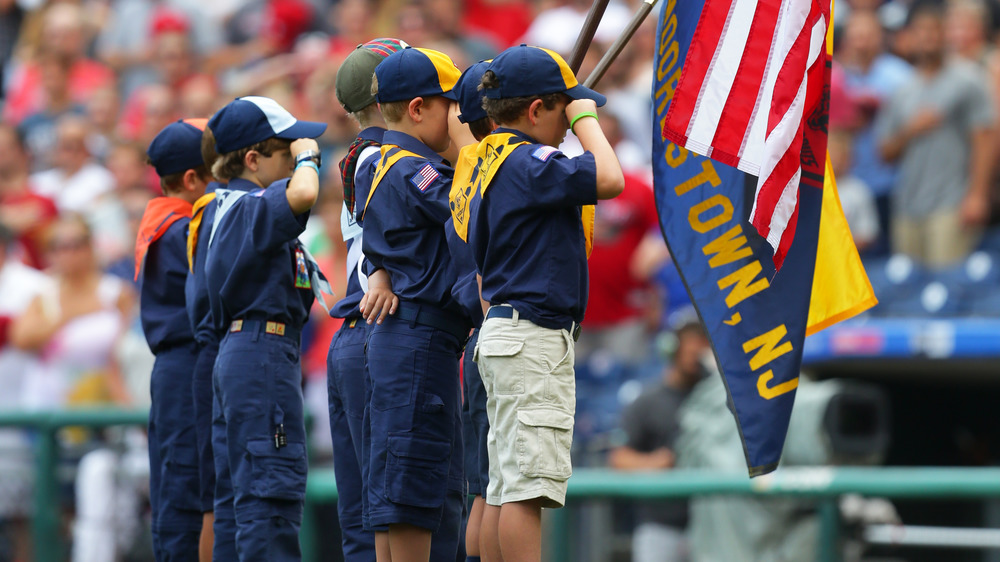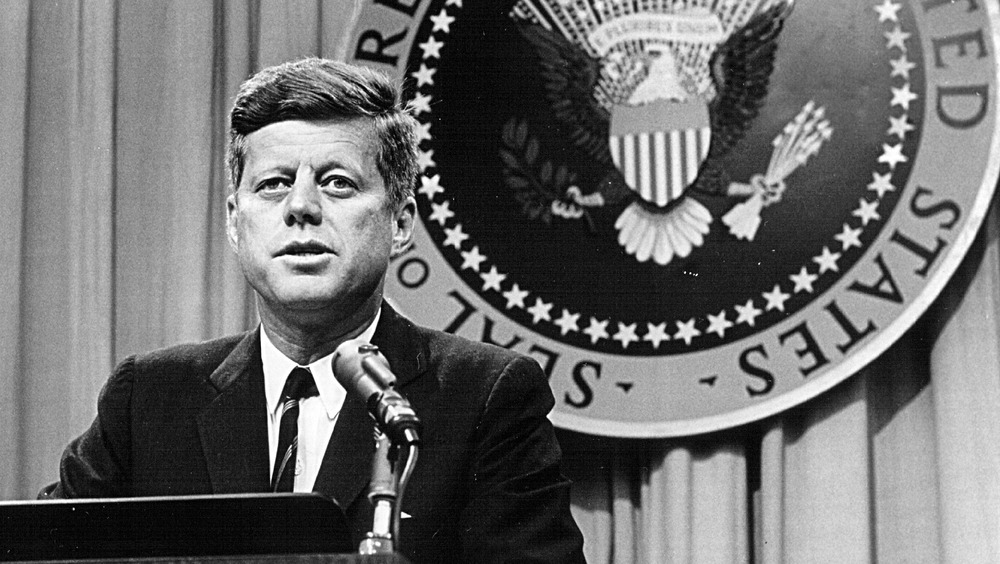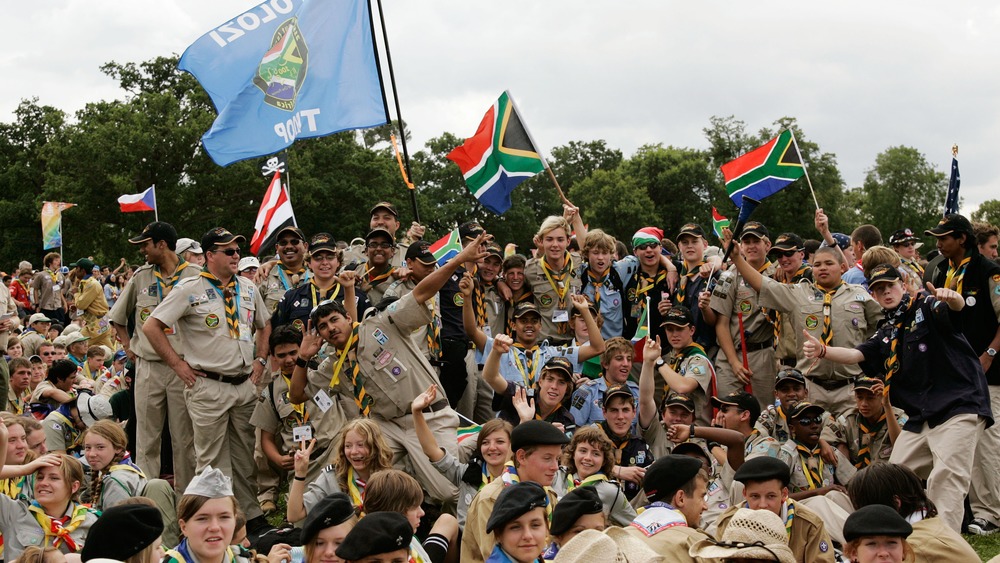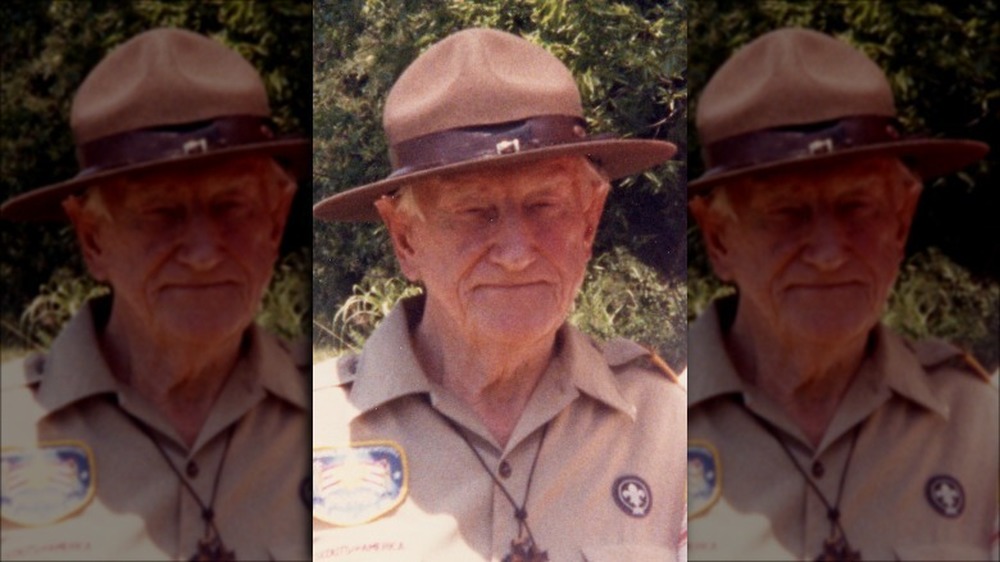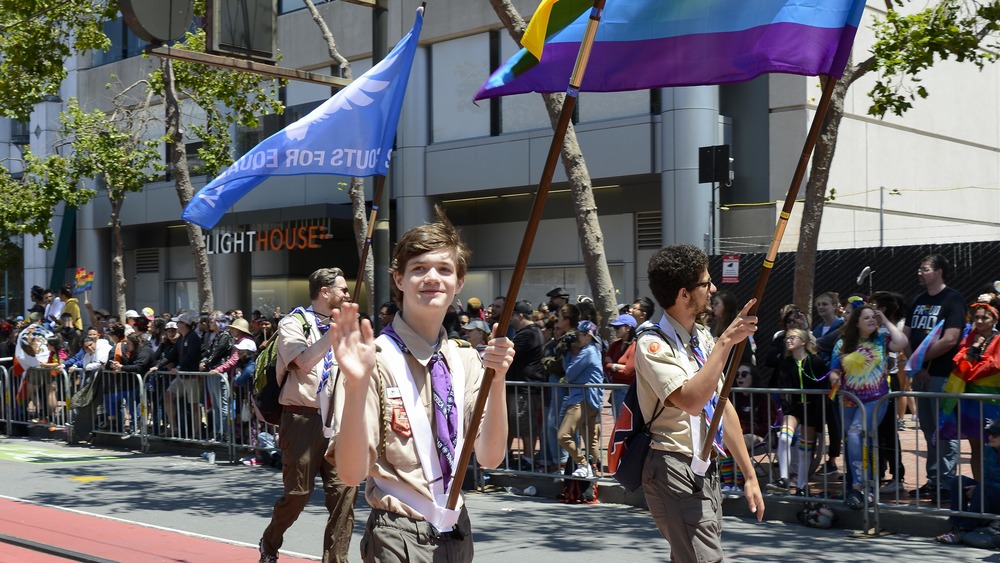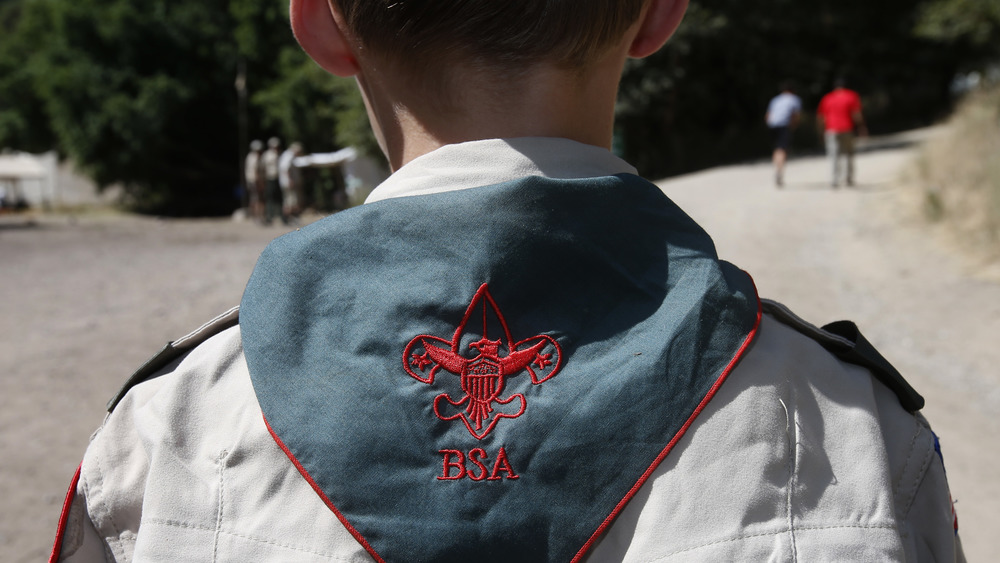The Long Complicated History Of The Boy Scouts Explained
The Boy Scouts have been in existence for more than a century. Despite struggling to find their footing as an organization in a changing world, they remain iconic — their penetration into popular culture is exemplified by the fact that calling someone a "boy scout" is to accuse them of being ethical and idealistic to a fault. Wherever you live, there's a very good chance there's a local Boy Scout Troop nearby taking kids on camping trips, teaching them outdoor skills, and making them wear those snazzy uniforms (which were designed by Oscar de la Renta).
Understanding where the Boy Scouts fit into the modern world requires us to understand how the organization fit into the world of the past, the forces that shaped its origins, and the events that have guided its evolution. A century of history is a lot, and the Boy Scouts is a very different organization today than it was when originally conceived — and is even a different organization than it was 10 or 20 years ago. Here's the long, complicated history of the Boy Scouts.
It all started in Britain
The roots of the Boy Scouts goes back to 1908 in Great Britain. As History.com tells us, Robert Baden-Powell, a hero of the South African War, published a military field manual called Aids to Scouting, which became popular among boys who found the idea of emulating soldiers tracking and observing the enemy great fun. Baden-Powell soon founded the Boy Scouts and recruited young boys into his military-flavored organization. It might have been a bit too military-flavored, actually — as BBC News reports, Baden-Powell held some pretty Nazi-sympathetic views and even held talks with the leader of the Hitler Youth in the 1930s. It makes sense — fascists love snazzy uniforms.
In 1910, though, no one had heard of Adolph Hitler. Public response to Baden-Powell's new group was very positive — as The Conversation notes, new child labor laws meant children couldn't be kept busy toiling away in factories any more, so scouting was seen as a way to keep them busy. An American businessman named William D. Boyce traveled to England and encountered a boy scout in London — legend has it the boy guided Boyce through a dense fog, but it's probably not true. However he came across the organization, The Washington Post tells us he took the idea (and a copy of the official handbook) back to America with him. He immediately founded the Boy Scouts of America based on Baden-Powell's ideas, combining some existing boys organizations under the new name.
There was a competing group and they were armed
Just like in England, the Boy Scouts took off very quickly in America. Success always breeds imitation and competition, so it's not terribly surprising that, according to the Digital History Project, a rival group called the American Boy Scouts (ABS) was founded shortly after W.D. Boyce organized the Boy Scouts of America (BSA). The rival group was sponsored by none other than newspaper mogul (and inspiration for Citizen Kane) William Randolph Hearst.
Hearst was notably competitive, and many suspect he was jealous of publisher Boyce's success. One key difference between Hearst's ABS and the BSA was that the American Boy Scouts leaned much harder into the militaristic side of scouting — as Popular Mechanics tells us, boys in the ABS were actually armed with guns and performed military-style drills using blank rounds in their weapons.
The ABS remained in operation for just under a decade. As Mental Floss reports, after incidents where scouts in the ABS accidentally shot each other, the organization changed its name to escape bad publicity. The new name, the United States Boy Scouts (USBS), caused a lot of confusion, so the BSA finally sued them, forcing them to stop using the word "scout" or "scouting" in their name. The USBS collapsed, leaving the BSA the lone scouting group standing.
Atheists have always been barred — and still are
The Boy Scouts have always striven for a wholesome image, and that earned them the early and lasting endorsement of churches and religious organizations everywhere. In fact, as Stacker reports, it was just a year after the official founding of the Boy Scouts of America that the organization's first CEO, James West, included the so-called "Religious Declaration" into official Boy Scout policy. The declaration strictly forbids any sort of discrimination based on religion — but it does require an acknowledgment of God's existence and includes many references to God throughout the BSA's literature and policies.
That means that atheists and agnostics have been officially barred from any sort of leadership position in the Boy Scouts since its earliest days. And as The Philadelphia Inquirer reports, despite the many changes the Scouts have made to support LGBTQ rights and to accept girls as well as boys, it still bars atheists and agnostics to this day. In fact, even as it becomes more tolerant to those other groups, the Boy Scouts have stiffened their resolve against atheists. As Scouting Magazine notes, in 2015 the Scouts included a requirement that every Scout "tell how you have done your duty to God" whenever they attain a new rank.
Boy's Life was launched in 1911 and is still published
When you think of magazines, you probably think of publications like National Geographic or Time, which have been around for decades and sport millions in circulation. But you should also think about Boy's Life, the official publication of the Boy Scouts, which has also been around for decades and sports a circulation of about a million.
As The World History Project reports, Boy's Life came to be in 1911, just a few months after the Boy Scouts of America was founded. The magazine started off as the passion project of an enthusiastic man named George S. Barton, who produced 5,000 copies of the first issue in January 1911. By 1912, the magazine had 6,000 subscribers, and the Boy Scouts of America purchased it for $1 per subscriber (which would be more than $150,000 in today's money). The BSA made Boy's Life the official magazine of scouting in America, and it has been continuously published ever since.
As if the official magazine of the Boy Scouts couldn't get any more American, one of the first art editors for Boy's Life was none other than Norman Rockwell. As the Norman Rockwell Museum notes, the celebrated artist worked just three years in the role before jumping over to The Saturday Evening Post, but he continued to feature scouts in his cover art for years. You can actually see every issue online, if you're curious.
Their record on racial justice isn't great
The Boy Scouts was founded on general principles of equality and inclusion. As The Conversation points out, from its earliest days the Boy Scouts of America rejected discrimination and made explicit efforts to include boys from all backgrounds in its ranks, specifying in its foundational documents that boys of any background could and should join.
Which is great — except, as The Daily Progress points out, the BSA was structured into local "councils," which were encouraged to follow local laws and customs. Which meant that if a Boy Scout Troop was created in an area that legally barred or discouraged Blacks and other minorities from joining, they went along with that. This way, the BSA was officially inclusive and tolerant without actually being particularly inclusive or tolerant at all.
And, as the African American Registry reports, the BSA's outreach efforts, which were supposed to encourage kids from various backgrounds to join, were rife with racist thought. The outreach program organized potential scouts into a category labeled "feeble-minded, delinquency areas, orphanages, and settlements," which meant Black scouts were lumped in with kids with disabilities — which tells you all you need to know about how scouting's leaders viewed race. There were Black boy scouts and Black troops in the BSA, of course — but in segregated fashion. In fact, the BSA remained segregated until 1974.
The first National Jamboree was organized by FDR
By the 1930s, the Boy Scouts had grown into a large and growing group, and during the Great Depression a country in desperate need of encouragement and positivity often found it in the scouts. As the population of scouts grew, the idea of organizing a national (and, eventually, international) gathering to celebrate scouting took hold. The first National Jamboree was scheduled for 1935 to celebrate the 25th anniversary of American scouting, and President Franklin D. Roosevelt — who had never been a scout, but had served in a leadership position prior to the presidency and who Scouting Magazine notes was a big supporter of scouting throughout his career — was going to be on hand to celebrate.
But as Scouting Magazine also reports, those plans were ruined by a polio epidemic. Rather than risk exposing thousands of kids to the disease, the jamboree was canceled, and it took two years to get it back on track.
As Scouting Magazine notes, the delay didn't dampen enthusiasm — nearly 30,000 scouts gathered from all over the country, pitching tents around the Washington Monument in July of 1937. Since that first gathering, there have been National Jamborees about every four years, and close to a million scouts have attended.
Scouting originally targeted a narrow age range
The Boy Scouts were originally geared towards boys aged 12 to 17, and there was immediate concern that this excluded younger boys. As Senior Scouting History notes, there was also concern over the "older boy problem" — the fact that 16-year old boys tend to have different interests than 13-year old boys and would start to drift away from scouting.
Efforts to deal with these issues date back almost to the very beginning — History.com notes that scouting's original founder Robert Baden-Powell established the Wolf Cubs for younger kids in 1916. In the U.S., there were unofficial efforts to involve younger kids using Baden-Powell's Wolf Cub materials, but as Scouting Magazine makes clear, it wasn't until 1927 that the Boy Scouts began working on an official program, and it wasn't until 1930 that the Cubbing program was launched. This eventually evolved into the Cub Scouts and was designed for younger kids.
For older kids, there were many disparate efforts to engage and retain them. As Scouting Magazine reports, there were Sea Scouts, Senior Scouts, Rovers, Air Scouts, and Explorers. In 1949, all of these programs except Sea Scouting were consolidated into the Explorers program, designed for older kids. The Explorers have continued to evolve, going totally coed in 1971, and today serve kids aged 14-20 with more of a focus on development and career training than outdoor skills.
The first Boy Scout president
While the Boy Scouts had the support and involvement of plenty of celebrities and politicians in its early years, no one associated adult success with scouting experience until later. In fact, it wasn't until the middle of the 20th century that "boy scout" began popping up on the resumes of famous and powerful people. As Reader's Digest notes, one of the biggest moments in scouting history occurred in 1960 when former boy scout John F. Kennedy was elected the 35th president of the United States — the first scout to become the commander in chief (Reference.com tells us there have been four more since — Gerald Ford, Bill Clinton, George W. Bush, and Barack Obama, although he was a member of the Indonesian Scout Association).
Kennedy never achieved scouting's highest rank of Eagle Scout — he stalled two ranks down as a Star Scout — but the BSA made him their national honorary president anyway. Since then, scouting and especially attaining the rank of Eagle Scout has been increasingly associated with success and achievement. As Scouting Magazine notes, famous Boy Scouts include men like Neil Armstrong, the first man to walk on the Moon, Civil Rights leader Martin Luther King, Jr., pitching legend Nolan Ryan, and billionaire Sam Walton. Being a Boy Scout might not guarantee success, but it doesn't seem to hurt.
Scouting is in decline
The peak of popularity for the Boy Scouts is widely considered to be the late 1960s and early 1970s. As PBS reports, membership in the Boy Scouts of America peaked in 1972 with about 6.5 million members, but those numbers have been going down steadily. In 1998, membership was about 4.8 million, but as The Chicago Tribune reports, that number had fallen to just 2.4 million by 2014. According to the Boy Scouts of America's 2019 Annual Report, that number is now down to a little over 2 million.
There's little doubt the Boy Scouts are in a decades-long decline, and there are many theories as to why, ranging from changes to the program instituted in the 1970s to the clash between a more tolerant society and the very traditional religious connections behind the Scouts — as well as the flurry of abuse lawsuits noted by NPR. But as The Washington Post explains, it's not all doom and gloom. In fact, the recent changes allowing LGBTQ people and girls to participate has driven up membership in some areas. The Boy Scouts remain one of the largest youth-oriented organizations in the country, which means it has the resources to reverse its decline and may yet do so.
A change to the program was a disaster
In 1972, according to PBS, membership in the Boy Scouts peaked at 6.5 million members, and things looked very good for the organization.
Then, in 1972, the Boy Scouts of America introduced the Improved Scouting Program.
As explained by Adventure Troop 97, the new program de-emphasized outdoor skills like camping, swimming, and hiking (dropping some from the Eagle Scout required list altogether) and extended its urban-oriented programs to all councils, whether they were in an urban area or not. The program changed just about every aspect of scouting in an effort to modernize while broadening scouting's appeal to city kids.
As Scouting Magazine notes, the Improved Scouting Program was an unmitigated disaster. After six years, membership had declined by nearly a third and there was open rebellion in the BSA. The Boy Scouts lured legendary writer and scouting enthusiast Bill "Green Bar Bill" Hillcourt out of retirement to write a completely revamped handbook that did away with many of the Improved Scouting Program's changes and created a more traditional one — which he did for free. The new handbook was an immediate success, selling 4.4 million copies when it was published in 1979.
The Boy Scouts resisted LGBTQ rights
As the Encyclopedia Britannica notes, for decades the Boy Scouts of America included phrases like "morally straight" and "clean" as requirements for membership — phrases which it very much interpreted to mean "not gay." In 1999, it expelled an assistant scoutmaster named James Dale when it discovered Dale was homosexual and very active in the gay rights movement. Dale promptly sued, and the case went to the Supreme Court. Since the BSA was a private organization, the court ruled in their favor.
But the times were changing around the Boy Scouts, and pressure to change its policies was growing. As The Los Angeles Times reports, in 2010 the Boy Scouts launched an official review of their policies at a time when more than half the country supported gay marriage. It took three years and even more pressure from LGBTQ groups, but in 2013 the Boy Scouts ended its ban on gay members. In 2015 it voted to allow gay adult leaders.
After that, changes came rapidly. In 2017 it welcomed its first transgender member, and as CNN notes, the Boy Scouts of America changed its name to Scouts BSA in 2019 when it voted to admit girls (as Bloomberg notes, absolutely enraging the Girl Scouts).
There's a horrifying abuse scandal
When you hear the phrase "sex abuse scandal" you probably think of the Catholic Church, which has spent decades dealing (poorly) with accusations against priests all over the world. But a similar scandal is currently tearing the Boy Scouts apart — and it's getting worse every day.
As The New York Times reports, there are now more than 82,000 separate accusations of abuse against the Boy Scouts, more than have been filed against the Catholic Church — by a big margin. The Boy Scouts had filed bankruptcy in early 2020, listing nearly $1 billion in assets, and the growing abuse claims have made that proceeding much more complicated as the potential liability of the Scouts grows daily.
As NPR notes, there is a long history of predators joining the Boy Scouts — and the Scouts actually kept records called Red Flag Files and (unbelievably) Perversion Files. Amazingly, despite keeping detailed records of abuse, the Boy Scouts never contacted law enforcement. The men whose crimes were documented in the Perversion Files were asked to leave the organization but usually found it very easy to move to a new location and join a new council or troop.
According to Time, Scouts BSA has committed to turning over the evidence they have on anyone accused of abuse and to providing counseling and other support to the victims, but there is a real possibility this scandal destroys the Boy Scouts.
